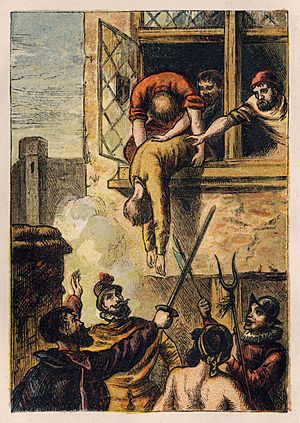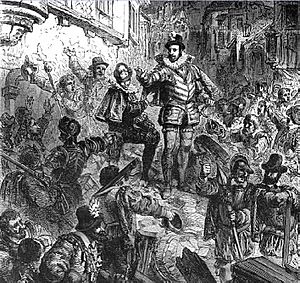Henry I, Duke of Guise facts for kids
Quick facts for kids Henry I |
|
|---|---|
|
|
 |
|
| Duke of Guise | |
| Reign | 24 February 1563 – 23 December 1588 |
| Predecessor | Francis |
| Successor | Charles |
| Born | 31 December 1550 |
| Died | 23 December 1588 (aged 37) Château de Blois, Blois, France |
| Spouse | Catherine of Cleves |
| Issue among others... |
|
| House | Guise |
| Father | Francis, Duke of Guise |
| Mother | Anna d'Este |
| Religion | Roman Catholicism |
| Signature | |
Henry I, Prince of Joinville, Duke of Guise, Count of Eu (born December 31, 1550 – died December 23, 1588) was an important French noble. People sometimes called him Le Balafré, which means 'Scarface'. He was the oldest son of Francis, Duke of Guise, and Anna d'Este.
Henry was a key leader during the French Wars of Religion. These were a series of conflicts between Catholics and Protestants in France. He was one of the main figures in the War of the Three Henrys. Henry was a strong opponent of Queen Mother Catherine de' Medici. He was later killed by the bodyguards of her son, King Henry III.
Contents
Early Life and Family
Henry was born on December 31, 1550. His father, Francis, Duke of Guise, was one of the most powerful nobles in France. His mother was Anna d'Este. When Henry was 12 years old, his father was killed. Henry then inherited his father's important titles. These included Governor of Champagne and Grand Master of France.
The Guise family, including Henry, wanted revenge for his father's death. They believed Gaspard II de Coligny was responsible. Henry tried to challenge Coligny to duels, but Coligny refused. Henry and his brother, Charles, Duke of Mayenne, later went to fight against the Ottoman Empire in Hungary. They served under Alfonso II d'Este, Duke of Ferrara.
Henry's Role in Politics
Henry played an active part in the religious wars. He fought in several battles, like the Battle of Saint-Denis in 1567. He also successfully defended Poitiers during a siege. He was wounded in battle and, like his father, became known as Le Balafre (Scarface). He became a hero to many Catholics in France. They saw him as a strong leader against the Huguenots (French Protestants).
In 1570, the third war of religion ended. A peace agreement was made, which included a marriage. Henry IV of Navarre, a Protestant, was to marry the King's sister, Margaret of Valois. This marriage was meant to bring peace. Around this time, Henry of Guise had a romance with Margaret. This made her brothers, King Charles IX and Henry, very angry. Henry of Guise was sent away from court. On October 3, he married Catherine of Cleves.
In August 1572, Henry IV and Margaret got married in Paris. Many Protestant leaders were in the city for the wedding. Soon after, Admiral Coligny was shot in an assassination attempt. Henry of Guise was a main suspect because of their long-standing feud.
The situation in Paris became very tense. The royal council decided to remove Protestant leaders. This led to the terrible St. Bartholomew's Day massacre. During this event, Henry of Guise oversaw the killing of Coligny. He tried to capture other targets but was not happy when the situation turned into a general massacre. He even protected some fleeing Protestants in his home.
The Catholic League
In 1576, Henry formed the Catholic League. This group aimed to protect Catholic interests in France. His relationship with the new King, Henry III, became very bad. This led to another conflict known as the War of the Three Henries (1584–1588).
In 1584, the King's brother, Francis, Duke of Anjou, died. This meant that Henry of Navarre, a Protestant, was next in line to the throne. Henry of Guise did not want a Protestant king. He made an agreement with Philip II of Spain, called the Treaty of Joinville. This agreement said that Cardinal de Bourbon should be king instead of Henry of Navarre.
King Henry III then sided with the Catholic League in 1585. They fought successfully against the Protestants. Henry of Guise sent his cousin to lead a rebellion in Picardy. King Henry III ordered Guise to stay in Champagne. But Guise ignored the King and entered Paris on May 9, 1588. This event was called the Day of the Barricades. It forced King Henry III to flee the city.
Assassination
The Catholic League now had control over France. The King had to agree to their demands. He even made Guise the Lieutenant-General of France. But King Henry III did not want to be controlled by the League. He decided to take a bold step.

On December 22, 1588, Henry of Guise was at the Château de Blois. The next morning, he was called to meet the King. There, he was killed by the King's bodyguards, known as "the Forty-five". King Henry III watched the assassination. Guise's brother, Louis II, Cardinal of Guise, was also killed the next day.
These killings made Guise's family and allies very angry. King Henry III had to seek safety with Henry of Navarre. The following year, King Henry III was also assassinated.
Issue
Henry married Catherine of Cleves (1548–1633) on October 4, 1570, in Paris. They had fourteen children together:
- Charles, Duke of Guise (1571–1640), who became Duke after his father.
- Henri (1572–1574)
- Catherine (born and died 1573)
- Louis III, Cardinal of Guise (1575–1621), who became Archbishop of Reims.
- Charles (born and died 1576)
- Marie (1577–1582)
- Claude, Duke of Chevreuse (1578–1657)
- Catherine (born 1579), died young.
- Christine (born and died 1580)
- François (1581–1582)
- Renée (1585–1626), an Abbess.
- Jeanne (1586–1638), an Abbess.
- Louise Marguerite (1588–1631)
- François Alexandre (1589–1614), a Knight of the Order of Malta.
In Literature and Film
Henry, Duke of Guise, appears as a character in many books and films.
- He is in Christopher Marlowe's play The Massacre at Paris.
- He also appears in George Chapman's plays Bussy D'Ambois and The Revenge of Bussy D'Ambois.
- John Dryden and Nathaniel Lee wrote a play called The Duke of Guise (1683).
- He is a character in the short novel The Princess of Montpensier by Madame de La Fayette.
- He appears in Alexandre Dumas's novel La Reine Margot and its sequels.
- He is also in Heinrich Mann's novel Young Henry of Navarre (1935).
- Ken Follett's novel A Column of Fire features Henry, Duke of Guise, and his role in the St. Bartholomew's Day massacre.
- In the 2010 film The Princess of Montpensier, he was played by actor Gaspard Ulliel.
Images for kids
See also
 In Spanish: Enrique I de Guisa para niños
In Spanish: Enrique I de Guisa para niños
- House of Guise






